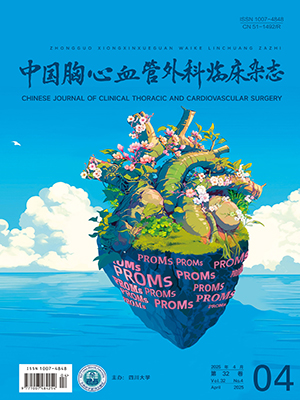| 1. |
Maisano F, Redaelli A, Pennati G, et al. The hemodynamic effects of double-orifice valve repair for mitral regurgitation: a 3D computational model. Eur J Cardiothorac Surg, 1999, 15(4): 419-425.
|
| 2. |
Nishimura RA, Otto CM, Bonow RO, et al. 2017 AHA/ACC focused update of the 2014 AHA/ACC guideline for the management of patients with valvular heart disease: A report of the American College of Cardiology/American Heart Association Task Force on Clinical Practice Guidelines. J Am Coll Cardiol, 2017, 70(2): 252-289.
|
| 3. |
Bortolotti U, Milano AD, Frater RW. Mitral valve repair with artificial chordae: a review of its history, technical details, long-term results, and pathology. Ann Thorac Surg, 2012, 93(2): 684-691.
|
| 4. |
Ibrahim M, Rao C, Savvopoulou M, et al. Outcomes of mitral valve repair using artificial chordae. Eur J Cardiothorac Surg, 2014, 45(4): 593-601.
|
| 5. |
易定华, 俞世强, 徐学增, 等. 我国胸腔镜微创心脏手术技术操作规范专家共识(征求意见稿第二版). 中国胸心血管外科临床杂志, 2016, 23(4): 315-318.
|
| 6. |
Tokunaga S, Yasuda S, Masuda M. Devised loop-in-loop technique in mitral valve repair. Asian Cardiovasc Thorac Ann, 2014, 22(9): 1132-1134.
|
| 7. |
Coutinho GF, Antunes MJ. Mitral valve repair for degenerative mitral valve disease: surgical approach, patient selection and long-term outcomes. Heart, 2017, 103(21): 1663-1669.
|
| 8. |
孔烨. 二尖瓣成形技术研究进展. 临床外科杂志, 2015, 23(9): 655-658.
|
| 9. |
Morimoto H, Tsuchiya K, Nakajima M, et al. Mitral valve repair for anterior leaflet prolapse: surgical techniques review and 16-year follow-up results. J Card Surg, 2008, 23(5): 426-430.
|
| 10. |
中华医学会胸心血管外科分会胸心血管分会心脏瓣膜专业. 中国心脏二尖瓣膜疾病(成人)外科修复技术临床应用理念. 中华胸心血管外科杂志, 2015, 31(12): 705-714.
|
| 11. |
Hysi I, Rebet O, Gautier L, et al. A standardized loop technique for mitral valve repair. Ann Thorac Surg, 2017, 103(1): e105-e106.
|
| 12. |
Okamoto K, Yozu R, Kudo M. Loop-in-loop technique in mitral valve repair via minithoracotomy. Ann Thorac Surg, 2012, 93(4): 1329-1330.
|
| 13. |
常青, 王吉显, 吴玉辉, 等. loop或loop in loop技术腱索重建加二尖瓣成形环置入术治疗二尖瓣关闭不全. 临床军医杂志, 2016, 44(2): 111-114.
|
| 14. |
Perier P, Hohenberger W, Lakew F, et al. Toward a new paradigm for the reconstruction of posterior leaflet prolapse: midterm results of the "respect rather than resect" approach. Ann Thorac Surg, 2008, 86(3): 718-725.
|
| 15. |
David TE, Omran A, Armstrong S, et al. Long-term results of mitral valve repair for myxomatous disease with and without chordal replacement with expanded polytetrafluoroethylene sutures. J Thorac Cardiovasc Surg, 1998, 115(6): 1279-1285.
|
| 16. |
von Oppell UO, Mohr FW. Chordal replacement for both minimally invasive and conventional mitral valve surgery using premeasured Gore-Tex loops. Ann Thorac Surg, 2000, 70(6): 2166-2168.
|
| 17. |
Kudo M, Yozu R, Kokaji K, et al. Feasibility of mitral valve repair using the loop technique. Ann Thorac Cardiovasc Surg, 2007, 13(1): 21-26.
|
| 18. |
姜兆磊, 梅举, 丁芳宝, 等. 改良人工腱索联合瓣环成形术在二尖瓣脱垂修复中的应用及远期随访结果. 中国胸心血管外科临床杂志, 2016, 23(5): 430-433.
|
| 19. |
Yano M, Sakaguchi S, Furukawa K, et al. A new method for the adjustment of neochordal length: the adjustable slip knot technique. Interact Cardiovasc Thorac Surg, 2015, 21(2): 240-242.
|
| 20. |
Pomerantzeff PM, Brandão CM, Leite Filho OA, et al. Mitral valve repair in rheumatic patients with mitral insuficiency: twenty years of techniques and results. Rev Bras Cir Cardiovasc, 2009, 24(4): 485-489.
|
| 21. |
Zhou YX, Leobon B, Berthoumieu P, et al. Long-term outcomes following repair or replacement in degenerative mitral valve disease. Thorac Cardiovasc Surg, 2010, 58(7): 415-421.
|




